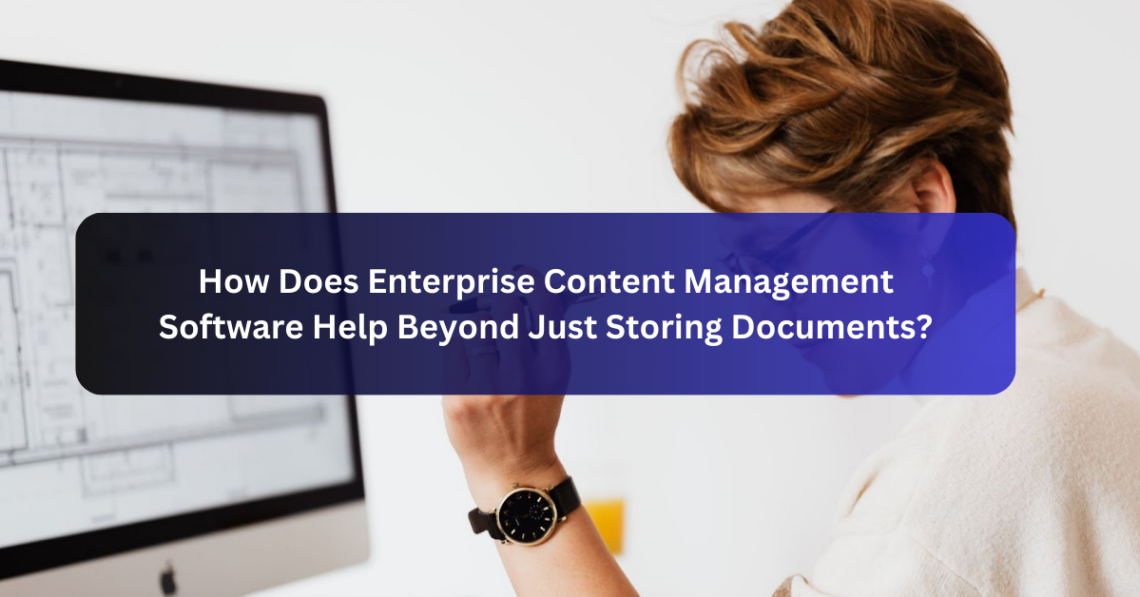
How Does Enterprise Content Management Software Help Beyond Just Storing Documents?
Enterprise Content Management (ECM) software may sound technical, but it’s more than an upgraded document storage system. Many think it’s just a digital filing cabinet, but ECM software does more than hold files.
In this article, we will explore what ECM can do. Get ready to discover how ECM software can streamline tasks, help teams work together better, keep everything safe, and fit into how a business runs. Let’s dive in!
How Does ECM Software Automate Routine Tasks?
ECM software automates routine tasks through a process known as workflow automation. Here’s a breakdown of how it works:
Workflow Design:
- Users define the sequence of tasks involved in a specific business process.
- Tasks can include document reviews, approvals, notifications, and more.
Task Assignment:
- The ECM system assigns tasks to individuals or groups based on predefined rules.
- Assignments are often based on roles, responsibilities, or expertise.
Automated Triggers:
- Triggers initiate tasks automatically based on predefined conditions.
- For example, the workflow is triggered when a document is uploaded, or a form is submitted.
Notifications and Alerts:
- ECM software sends automated notifications to relevant stakeholders.
- Users receive alerts about pending tasks, approaching deadlines, or any changes in the workflow.
Parallel Processing:
- Workflows can be designed for parallel processing, allowing multiple tasks to occur simultaneously.
- This speeds up overall process completion.
Data Integration:
- Integration with other systems makes sure that there is seamless data exchange during the workflow.
- This minimizes manual data entry and reduces the risk of errors.
Decision Points:
- Workflows often include decision points where the system automatically routes tasks based on certain conditions.
- For instance, if a document requires approval, the workflow may route it to the designated approver.
Audit Trails:
- ECM software maintains detailed audit trails of workflow activities.
- This provides transparency and accountability, which are crucial for compliance and process improvement.
Performance Monitoring:
- Users can monitor the performance of workflows in real-time.
- Analytics and reports help identify bottlenecks and areas for optimization.
Continuous Improvement:
- Based on data and feedback, organizations can continuously refine and improve workflows.
- This adaptability ensures that processes stay efficient and aligned with business needs.
How Does ECM Software Enhance Team Communication And Collaboration?
ECM software enhances team communication and collaboration through various features and functionalities that streamline interactions and facilitate efficient teamwork.
Here’s how ECM contributes to improved collaboration:
Shared Workspaces:
- ECM provides shared digital spaces where team members can collaborate on projects.
- These workspaces centralize documents, discussions, and project-related information.
Real-time Editing:
- Team members can collaboratively edit documents in real-time within the ECM system.
- Changes are instantly visible to all authorized users, promoting seamless collaboration.
Version Control:
- ECM software maintains version history for documents, preventing conflicts in edits.
- Team members can access and revert to previous versions if needed.
Document Commenting and Annotations:
- Users can add comments and annotations directly to documents.
- This fosters communication within the context of the content being reviewed.
Task Assignment and Tracking:
- Tasks can be assigned within the ECM system, linking them to specific documents or projects.
- Team members can track the progress of assigned tasks, promoting accountability.
Discussion Forums:
- ECM platforms often include discussion forums or chat features.
- Team members can communicate asynchronously, sharing ideas and updates.
Integration with Communication Tools:
- Integration with email, instant messaging, and other communication tools.
- This ensures that ECM becomes part of the broader communication ecosystem.
Access Controls:
- ECM allows granular control over access permissions.
- Team members have access only to the information relevant to their roles, ensuring data security.
Mobile Accessibility:
- Many ECM systems offer mobile apps, enabling team members to collaborate on the go.
- This flexibility enhances communication, especially for remote or dispersed teams.
Searchable Content:
- ECM’s advanced search capabilities help teams quickly find the information they need.
- This cuts down the time spent searching for documents and fosters productivity.
Collaborative Workflows:
- Workflows in ECM can be designed to involve multiple team members in sequential or parallel tasks.
- This ensures that collaboration is embedded into business processes.
Training and Onboarding:
- ECM systems can store training materials and resources, aiding in team onboarding.
- This centralized knowledge base promotes consistency and standardization.
Role of ECM Platform in Improving Information Accessibility and Management
The ECM platform is crucial in improving information accessibility and management within an organization. Here are critical aspects of how ECM contributes to this:
Centralized Data Repository:
- ECM is a centralized repository for storing and organizing various types of content, including documents, images, and multimedia.
- This centralization streamlines access to information and eliminates data silos.
Advanced Search Capabilities:
- ECM platforms feature advanced search functionalities, allowing users to locate specific information quickly.
- Metadata, tags, and full-text search options enhance precision in retrieving relevant content.
Categorization and Tagging:
- Content in ECM is organized through categorization and tagging.
- This systematic approach simplifies content management and ensures that information is easily retrievable.
Version Control:
- ECM systems maintain version control for documents, preventing confusion over the latest version.
- Users can access and track changes, ensuring they work with the most up-to-date information.
Document Lifecycle Management:
- ECM manages the entire lifecycle of documents, from creation to archiving or deletion.
- This ensures that information is appropriately managed throughout its existence.
Access Controls and Permissions:
- ECM allows organizations to set access controls and permissions.
- Only authorized users can access specific information, ensuring data security and compliance.
Audit Trails:
- Detailed audit trails track user activities within the ECM system.
- This provides a record of who accessed what information and when enhancing accountability.
Integration with Business Systems:
- This integration contributes to a unified view of information across the organization.
Document Indexing:
- ECM platforms often use document indexing to assign keywords and metadata.
- This makes it easier to organize and retrieve documents based on specific criteria.
Collaborative Workspaces:
- Shared workspaces in ECM facilitate collaboration and information sharing among team members.
- This contributes to a collaborative culture and ensures that information is not confined to individual silos.
Final Words:
ECM software surpasses its reputation as a mere document storage tool. ECM is a game-changer for businesses, streamlining processes and enhancing overall efficiency.
As you reflect on the insights shared, consider the broader impact ECM can have on your business processes. It’s not just about managing files; it’s about transforming your organization’s operations.
Take the next step and explore how embracing ECM can propel your business into a new era of productivity and innovation.
You May Also Like

Tips for Maintaining for Your Level 2 Charger
December 1, 2023
7644fg.j-7doll – A Comprehensive Guide!
March 1, 2025

